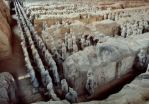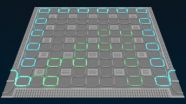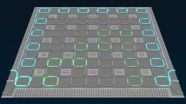(Press-News.org) Even as he conquered rival kingdoms to create the first united Chinese empire in 221 B.C., China's First Emperor Qin Shihuang ordered the building of a glorious underground palace complex, mirroring his imperial capital near present-day Xi'an, that would last for an eternity.
To protect his underworld palaces, the First Emperor issued instructions that his imperial guard be replicated, down to the finest details, in red-brown terracotta clay, poised to do battle. Thousands of these imperial guards were initially discovered in 1974; some contained patches of pigment that had survived 22 centuries buried underground, along with minute remnants of binding media that had aided in the creation of this polychrome Terracotta Army.
Efforts to conserve, and perhaps even restore, these remarkable examples of sculpture in the round from the first empire have been hampered by the failure of a series of scientific experiments to pinpoint the binding material used in applying pigments to Qin Shihuang's underground army.
More than a quarter-century ago, the United Nations Educational, Scientific and Cultural Organization inscribed the Mausoleum of the First Qin Emperor on its World Heritage List – a chronicle of the most fantastic and important cultural and historical sites around the world.
Describing the site, UNESCO experts stated: "Qin (d. 210 B.C.), the first unifier of China, is buried, surrounded by the famous terracotta warriors, at the center of a complex designed to mirror the urban plan of the capital, Xianyang. The small figures are all different; with their horses, chariots and weapons, they are masterpieces of realism and also of great historical interest."
Describing the site as "one of the most fabulous archaeological reserves in the world," UNESCO experts pointed out the immense value of investigating the technology involved in creating and coloring these lifelike warriors: "The documentary value of a group of hyper realistic sculptures where no detail has been neglected - from the uniforms of the warriors, their arms, to even the horses' halters - is enormous. Furthermore, the information to be gleaned from the statues concerning the craft and techniques of potters and bronze-workers is immeasurable."
Archaeological excavations and research conducted since the discovery of the First Emperor's polychrome army have revealed "the surfaces of the terracotta warriors were initially covered with one or two layers of an East Asian lacquer … obtained from lacquer trees," according to Hongtao Yan and Jingjing An, scientists at the College of Chemistry and Materials Science, Northwest University, in the Chinese city of Xi'an.
In an article coauthored with Tie Zhou, Yin Xia and Bo Rong, scholars at the Key Scientific Research Base of Ancient Polychrome Pottery Conservation, the State Administration for Cultural Heritage, connected with the Museum of Emperor Qin Shihuang's Terracotta Army, these researchers stated: "This lacquer was used as a base-coat for the polychrome layers, with one layer of polychrome being placed on top of the lacquer in the majority of cases."
These five scholars likewise revealed in the study, which was published in the Chinese Science Bulletin, that polychrome layers applied to these sculpted imperial guards were composed of natural inorganic pigments and binding media. These pigments have been identified as including cinnabar [HgS], apatite [Ca5(PO4)3OH], azurite [Cu3(CO3)2(OH)2] and malachite [Cu2CO3(OH)2], etc., but the precise composition of binding media used in the painting process had long eluded scientists.
Research aimed at solving this puzzle faced an array of obstacles: extremely low levels the proteinaceous binding media in the polychrome layers of Qin Shihuang's terracotta army have survived being submerged in almost six meters of water-saturated loess for more than two millennia.
"Following almost 22 centuries of storage under these conditions, the remaining pieces of original polychromy that have survived on the sculptures contain extremely small amounts of the binding media," the researchers wrote in an article titled "Identification of proteinaceous binding media for the polychrome terracotta army of Emperor Qin Shihuang by MALDI-TOF-MS."
"A large amount of the polychromy has already been lost through pillaging as well as damage resulting from fires and the long-lasting effect of water," they explained.
To solve the more than 2000-year-old enigma, these researchers used matrix-assisted laser desorption/ionization time-of-flight mass spectrometry (MALDI-TOF-MS) to identify the binding material. MALDI-TOF-MS offers high levels of sensitivity, requires only a minimal sample pretreatment process and can be used to reliably identify different types of proteinaceous material.
The researchers prepared "artificially aged" model samples by mixing different pigments with either animal glue or an adhesive concocted from free-range chicken eggs. To replicate the processes involved in the degradation of the pigments and binding media of the actual terracotta warriors, the model samples were buried in loess soil at a depth of one meter for one year.
Historical samples of the polychrome terracotta army were obtained from the Museum of Emperor Qin Shihuang's Terracotta Army in Xi'an to facilitate a comparative analysis.
Proteins were extracted from the model samples and from the historical samples, and the extracts were subjected to an ultrasonic bath treatment. The mixtures were then centrifuged and the supernatants collected. A method involving the complexation of EDTA in combination with dialysis was used to eliminate any interference in the polychrome layers taken from the historical samples. The extracted proteins were hydrolyzed with Sequencing grade trypsin to generate peptide fragment.
The binding media of the historical and model samples were analyzed by MALDI-TOF-MS, and the resulting peptide mass fingerprints of each sample were compared.
The peptide mass fingerprints of the historical samples were very similar to those of the animal glue model samples, having most peak masses in common.
The data obtained from the peptide mass fingerprints revealed that animal glue was present in the polychrome layers of Qin Shihuang's terracotta army even though this proteinaceous binding material underwent significant changes in terms of protein content during the two millennia the terracotta army was deployed underground. The binding media could be ascertained due to the fact that the peptide mass fingerprint of the animal glue proteins could be identified with certainty.
"To the best of our knowledge," wrote the five researchers, "this work represents the first account of the proteinaceous binding media from a 2200-year-old historical sample in China being identified by MALDI-TOF-MS."
INFORMATION:
This research was funded by the National Key Technology R&D Program, China (No. 2010BAK67B12 ).
See the article:
H. Yan, J. An, T. Zhou, Y. Xia, B. Rong, "Identification of proteinaceous binding media for the polychrome terracotta army of Emperor Qin Shihuang by MALDI-TOF-MS," Chin. Sci. Bull. (2014) 59(21):2574–2581.
doi: 10.1007/s11434-014-0372-9
This article was published online, in the Chinese Science Bulletin, by Science China Press and Springer-Verlag Berlin Heidelberg.
Science China Press is a leading publisher of scientific journals in China, and operates under the auspices of the Chinese Academy of Sciences. Science China Press presents to the world leading-edge advancements made by Chinese scientists across a spectrum of fields.
http://www.scichina.com/
Scientists solve 2,000-year-old mystery of the binding media in China's polychrome Terracotta Army
2014-08-01
ELSE PRESS RELEASES FROM THIS DATE:
Advances in assisted reproduction create more options and new legal issues for LGBT couples
2014-08-01
New Rochelle, NY, August 1, 2014—Lesbian, gay, bisexual, and transgender individuals who want to conceive a child may face the same problems as some of their heterosexual and cisgendered peers, such as reduced fertility, but in addition they often face additional physiological and legal challenges to become parents. A comprehensive review of the most recent advances in assisted reproduction options is presented in the article "LGBT Assisted Reproduction: Current Practice and Future Possibilities," published in LGBT Health, a peer-reviewed journal from Mary Ann Liebert, ...
On-chip topological light
2014-08-01
Topological transport of light is the photonic analog of topological electron flow in certain semiconductors. In the electron case, the current flows around the edge of the material but not through the bulk. It is "topological" in that even if electrons encounter impurities in the material the electrons will continue to flow without losing energy.
In the photonic equivalent, light flows not through and around a regular material but in a meta-material consisting of an array of tiny glass loops fabricated on a silicon substrate. If the loops are engineered just right, ...
Expressive writing may help breast cancer survivors
2014-08-01
Writing down fears, emotions and the benefits of a cancer diagnosis may improve health outcomes for Asian-American breast cancer survivors, according to a study conducted by a researcher at the University of Houston (UH).
"The key to developing an expressive writing intervention is the writing instruction. Otherwise, writing is just like a journal recording facts and events. Writing a journal can be therapeutic, but oftentimes we don't get the empirical evidence to determine whether it's effective or not," said Qian Lu, assistant professor and director of the Culture ...
Mapping the optimal route between two quantum states
2014-08-01
As a quantum state collapses from a quantum superposition to a classical state or a different superposition, it will follow a path known as a quantum trajectory. For each start and end state there is an optimal or "most likely" path, but it is not as easy to predict the path or track it experimentally as a straight-line between two points would be in our everyday, classical world.
In a new paper featured on the July 30 cover of Nature, scientists from the Institute for Quantum Studies at Chapman University, the University of Rochester, University of California at Berkeley, ...
Cordilleran terrane collage
2014-08-01
Boulder, Colo., USA - In the August 2014 issue of LITHOSPHERE, Steve Israel of the Yukon Geological Survey and colleagues provide conclusions regarding the North American Cordillera that they say "are provocative in that they blur the definition of tectonic terranes, showing that many observations of early geologists can be attributed to evolving geologic processes rather than disparate geologic histories."
Western North America is characterized by the Cordilleran accretionary mountain belt, which has seen episodic plate convergence since the early Paleozoic, about 253 ...
On-chipt topological light
2014-08-01
Topological transport of light is the photonic analog of topological electron flow in certain semiconductors. In the electron case, the current flows around the edge of the material but not through the bulk. It is "topological" in that even if electrons encounter impurities in the material the electrons will continue to flow without losing energy.
In the photonic equivalent, light flows not through and around a regular material but in a meta-material consisting of an array of tiny glass loops fabricated on a silicon substrate. If the loops are engineered just right, ...
Society bloomed with gentler personalities and more feminine faces
2014-08-01
DURHAM, N.C. -- Modern humans appear in the fossil record about 200,000 years ago, but it was only about 50,000 years ago that making art and advanced tools became widespread.
A new study appearing Aug. 1 in the journal Current Anthropology finds that human skulls changed in ways that indicate a lowering of testosterone levels at around the same time that culture was blossoming.
"The modern human behaviors of technological innovation, making art and rapid cultural exchange probably came at the same time that we developed a more cooperative temperament," said lead author ...
History of culture visualized through art history, physics, complexity
2014-08-01
Coral Gables, Fla. (July 31, 2014) -- Quantifying and transforming the history of culture into visual representation isn't easy. There are thousands of individual stories, across thousands of years, to consider, and some historical conditions are nearly impossible to measure.
Addressing this challenge, Dr. Maximilian Schich, associate professor of arts and technology at The University of Texas at Dallas, brought together a team of network and complexity scientists, including University of Miami physicist Chaoming Song, to create and quantify a big picture of European ...
'Normal' bacteria vital for keeping intestinal lining intact
2014-08-01
August 1, 2014 — (BRONX, NY) — Scientists at Albert Einstein College of Medicine of Yeshiva University have found that bacteria that aid in digestion help keep the intestinal lining intact. The findings, reported online in the journal Immunity, could yield new therapies for inflammatory bowel disease (IBD) and a wide range of other disorders.
The research involved the intestinal microbiome, which contains some 100 trillion bacteria. The role of these microorganisms in promoting or preventing disease is a major emerging field of study. Einstein scientists found that absorption ...
A train of 5 tropical cyclones in the Central and Eastern Pacific
2014-08-01
A train of developing tropical low pressure areas stretch from the Eastern Pacific Ocean into the Central Pacific and they were captured in an image from NOAA's GOES-West satellite on August 1. The train of five tropical lows include the remnants of Tropical Storm Genevieve and newly developed Tropical Storm Iselle.
NOAA's GOES-West satellite captured an image of the Pacific Ocean on August 1 at 1200 UTC (8 a.m. EDT) that showed post-tropical cyclone Genevieve's remnants between three other systems. The GOES-West image shows the train of storms with a well-developed Iselle ...









